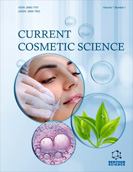Abstract
Aim: This work aimed to determine whether the oxybenzone-loaded nanocapsule gel (NC gel) can reduce the degree of skin penetration and, thereby, the skin irritation caused by the drug.
Background: Sunscreens must be retained on the uppermost skin surface, forming a protective film throughout the entire UV exposure period. Skin penetration and/or light-induced decomposition of sunscreens is undesirable as this would decrease the expected UV protection. The changes in colour and appearance of the sunscreen, as well as the possible increase in the phototoxicity and allergenic potential of sunscreen breakdown products, are also of concern.
Furthermore, exposure to UVB radiation leads to impairment in the stratum corneum and hence enhances the skin's penetration of sunscreen actives, leading to systemic absorption. Currently, available sunscreen agents are low-molecular-weight lipophilic molecules, which make them capable of penetrating the skin and being systemically absorbed.
Oxybenzone is an organic compound widely used in commercial sunscreen preparations. The low molecular weight and lipophilic nature of oxybenzone facilitate penetration through the stratum corneum, leading to irritation and allergic reactions.
Polymeric nanocapsules (NCs) have been developed to ensure a controlled release of pharmaceutical and cosmetic agents and/or exert a preventive effect against the harmful side effects induced by direct contact of tissues with high amounts of the drug. Hence, we hypothesised that encapsulating the oxybenzone polymeric nanocapsule system would reduce the irritation and its allergic potential upon topical application.
Objective: The current study aimed to develop a polymeric nanocapsule-based gel of oxybenzone and investigate its skin deposition by ex vivo permeation studies.
Methods: The polymeric nanocapsules were prepared by the solvent displacement method using a combination of Eudragit RSPO and Eudragit RLPO polymers. Further nanocapsules were incorporated into the xanthan gum gel base. It was evaluated for particle size, PDI, zeta potential, drug content, in vitro release, ex vivo permeation, sunscreen efficacy and skin irritation potential by the HET CAM test.
Results: Particle size, PDI, zeta potential, percent encapsulation, and loading of drug-loaded nanocapsule suspension were found to be 237.1 nm, 0.189 + 58.4 mV, 852 ± 0.5%, and 19.45 ± 0.94%, respectively. DSC results indicate the suitability of selected excipients. In vitro release studies indicated 68.99% oxybenzone release from NC suspension, while NC gel showed 58.87% at the end of 24 hrs. Ex vivo permeation results showed significantly higher drug permeation from plain oxybenzone gel than NC gel. Permeation flux and reduction ratio suggest a three-fold reduction in skin permeation by NC gel. The gel offered medium-level sun protection with an SPF value of 22.12. According to the HET CAM study, there was no evidence of skin irritation caused by NC gel.
Conclusion: It is concluded that the encapsulation of oxybenzone prevents direct interaction with the skin, reducing the chances of skin irritation and penetration. Results suggest that nanocapsules in gel bases can provide a promising formula for safer topical delivery of sunscreen.
[http://dx.doi.org/10.1016/j.jaad.2010.01.005] [PMID: 21292345]
[http://dx.doi.org/10.26850/1678-4618eqj.v44.2.2019.p26-36]
[http://dx.doi.org/10.1016/j.xphs.2019.09.009] [PMID: 31521640]
[http://dx.doi.org/10.1002/jps.23146] [PMID: 22488174]
[http://dx.doi.org/10.5681/bi.2012.011] [PMID: 23678444]
[http://dx.doi.org/10.1177/117739280700200002] [PMID: 21901071]
[http://dx.doi.org/10.1016/j.ijpharm.2016.03.018] [PMID: 26976501]
[http://dx.doi.org/10.1111/j.1365-2605.2012.01280.x] [PMID: 22612478]
[http://dx.doi.org/10.1081/PDT-200031456] [PMID: 15458238]
[http://dx.doi.org/10.1080/10717544.2017.1337823] [PMID: 28617150]
[http://dx.doi.org/10.1017/CBO9781107415324.004]
[http://dx.doi.org/10.1016/j.ijpharm.2008.08.021] [PMID: 18790032]
[http://dx.doi.org/10.3109/02652040903067844] [PMID: 19622017]
[http://dx.doi.org/10.1021/acs.chemrev.5b00346] [PMID: 26854975]
[http://dx.doi.org/10.1538/expanim.60.373] [PMID: 21791877]
[http://dx.doi.org/10.1166/jnn.2016.11670] [PMID: 27433583]
[http://dx.doi.org/10.3390/cosmetics5010001]
[http://dx.doi.org/10.1111/j.1468-2494.2008.00453.x] [PMID: 18713072]
[http://dx.doi.org/10.1016/j.bjp.2015.11.006]
[http://dx.doi.org/10.14573/altex.1710091] [PMID: 29534246]
[http://dx.doi.org/10.1159/000068291] [PMID: 12566826]
[http://dx.doi.org/10.15171/apb.2015.043] [PMID: 26504751]
[http://dx.doi.org/10.4314/tjpr.v8i2.44523]
[http://dx.doi.org/10.4172/2329-6631.1000171]
[http://dx.doi.org/10.1046/j.1365-2125.1999.00056.x] [PMID: 10583038]
[http://dx.doi.org/10.1016/j.ijpharm.2016.03.046] [PMID: 27130364]
[http://dx.doi.org/10.1016/j.ijpharm.2010.07.028] [PMID: 20670679]
[http://dx.doi.org/10.3390/cosmetics6040064]
[http://dx.doi.org/10.1166/jnn.2012.5832] [PMID: 23035447]
[http://dx.doi.org/10.3390/toxics7040051] [PMID: 31546707]









